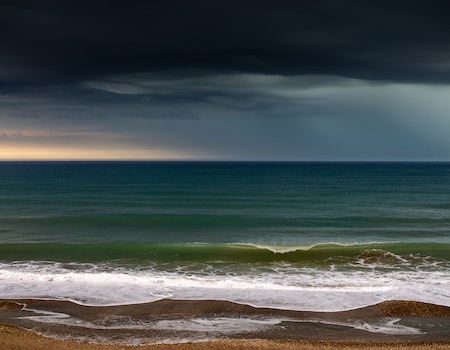Bonfires Ocean Beach
Stories similar to this that you might like too.
As dawn broke over the cliffs of Ocean Beach, a group of people watched in silence. The sun had not yet touched the tops of the jagged rocks and crags that towered above them but the air was already warm. It would be another hot day here on this rocky headland, where the Pacific’s icy waters crashed against a sharp black volcanic rock before tumbling into the crashing waves below.
There were no roads or tracks leading down from the road at Kailua-Kona, just steep cliffs and treacherous slopes, so getting there involved climbing, walking along ridges, and up narrow paths through dense vegetation until one was out on the cliff top.
The views from there were breathtaking: across the open ocean to the distant islets of Molokai and Lanai, with the islands of Maui beyond, rising like great green mountains against the blue sky; far off, the towering volcanoes of the Big Island itself – Mauna Loa and Mauna Kea – as well as other peaks that rose above clouds; even further away, to the east, was the island of Hawaii.
This spot overlooked a vast bay, which had been named for the whales it attracted after a whaler by the name of Captain Cook had first seen the area. Whale Bay now had a small village, where houses clustered close together among the trees.
A few people could be seen working in gardens, others were fishing, and some had gathered seaweed to dry while a group of children played in the shallows nearby.
At first glance, the village seemed idyllic. But as a number of observers looked upon their surroundings they felt something wasn’t right. There was a sense that something bad was coming. People were tense as they waited for the next act to unfold. They knew what was coming because it had happened before, and there was a fear in their hearts that it would happen again.
There was no doubt about who would play the role of the killer whale. It would be a man named William Pitt. He was an experienced boat captain and a good friend to many of the villagers. He was also known as “the Whale Killer” – a man who hunted whales in the Hawaiian sea.
This nickname came from his past deeds when he’d taken part in a mass slaughter of a pod of killer whales that was considered by many to have been a crime against nature. His reputation grew each year and his fame spread around the world.
The village’s residents were well aware of this fact, and some of them were very unhappy about the way things were going. One person, a woman called Lydia O’Malley, said that she wanted Pitt out of the community. She told her husband, a fisherman named John Murphy, “I’m worried about Pitt. I don’t trust him anymore.” He replied, “Me neither.”
Murphy was right to feel that way. It turned out that Pitt had been spying on the villagers all along, and his activities were about to get worse…
***
A Whale of a Tale
It took William Pitt years to become known as a great whaling boat captain, but when he did, he became infamous throughout the Pacific and beyond.
The young lad had grown up in Scotland. As he entered adulthood his family moved to the Isle of Skye where Pitt learned how to sail, taking on a number of odd jobs before becoming a sailor. In 1827, he arrived on Hawaii’s Big Island. Here he set up shop and began to make a name for himself as an accomplished ship captain and whaler.
Pitt was skilled at finding whales, which made him one of the most sought-after captains in the area. However, as his skills grew he realized that his main source of income came from killing whales instead of hunting them for food. The whales were highly prized – especially if you could bring back several of them to sell.
In 1831, Pitt returned home from a long trip only to discover that his father had died in an accident. To pay his debt to his family, Pitt went back to his old trade, whaling – only now he was much more successful.
The young whaling ship captain was making a good living from whale hunting. But then he discovered a new source of cash. It came in the form of a large sum of money offered to him by a wealthy American named William Seward. At first, Pitt refused the offer but the American pressed him until he agreed.
Seward wanted Pitt to kill a specific group of whales called makupakuas. These massive creatures lived in pods – sometimes numbering as many as a hundred. They were also known as black dolphins for their dark coloration.
The makupakuas were so rare that even though Seward offered Pitt a huge amount of money for bringing them back to his side of the Pacific Ocean, the young captain was willing to give it a go.
Pitt’s success with whales led to him gaining more attention from his American employer. He eventually earned enough money to buy his own boat and establish his own business, where he took tourists on whale-watching excursions and sold souvenirs.
His newfound wealth allowed him to travel around the world, meeting famous men like Theodore Roosevelt (the president of the United States) and John Jacob Astor (a businessman and entrepreneur).
By the early 1830s, Pitt had become such a popular figure that he decided to return to Hawaii and start his own family. He found work as a boat captain on the island of Molokai and married a local girl. Together they had four children: Mary, James, Sarah, and William.
But just two years after getting married, tragedy struck. On January 1st, 1838, the family heard about the horrific news. A group of sailors from California had recently arrived at Pearl Harbor, and during their stay, they were involved in a terrible incident. They had killed and eaten some of the native people and were being pursued by Hawaiian warriors.
The sailors fled to another settlement on the islands, and there they hid from their pursuers. During this time the Californian soldiers stole three small pigs. These pigs were considered sacred by the local residents, who had no idea what had happened to them.
This was bad enough, but things got much worse. The pig thieves started to roast and eat the three stolen pigs. Then they drank alcohol and ate the pig’s blood, which was considered to have special powers. Finally, they performed a ritual to call on the spirits of the dead piglets, and they danced with the pig’s skulls held high.
At this point the natives became suspicious, and soon they caught the Californians. They beat the sailors to death and then buried them in a deep pit. This is where the sailors stayed until Pitt’s family discovered them.
They were left there, in the hot sun, for six months. The sailors had been horribly mutilated and burned; one had died while still alive and another was still alive when Pitt found the body.
William Pitt’s family couldn’t stomach the sight and so they ordered the sailors buried on a nearby hillside. The bodies were laid out so that the eyes stared at the sky. It’s thought that this was done to show the dead sailors’ defiance against the forces of evil that had killed them. The site would later be used as a cemetery for victims of disease or violence.
After seeing the horror that had befallen the crew of California, Pitt vowed not to take passengers onto his whaleboats for fear of something similar happening. Instead, he would hunt whales alone on quiet days and use them to sell oil and meat to other ships passing through.
However, in 1841 the Hawaiian government decided to stop whale hunting, and so Pitt’s career was over. His family moved away and he became a sailor, working on various ships.
In 1846 he met a woman named Jane and they married. She gave birth to five children together: William Jr., George, Jane, Charles, and John.
Pitt died of a stroke on July 6th, 1867.
The End


